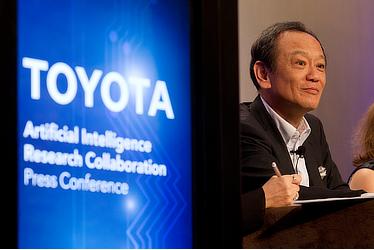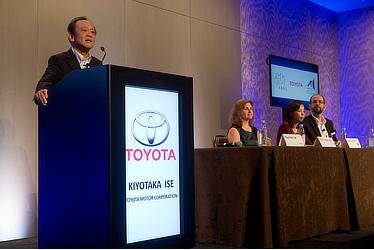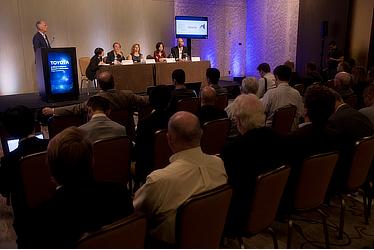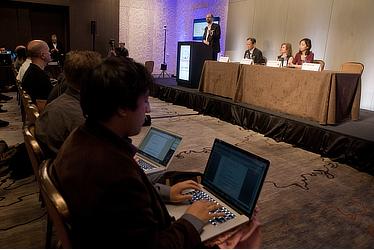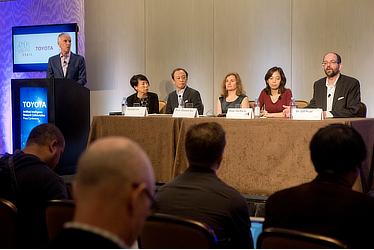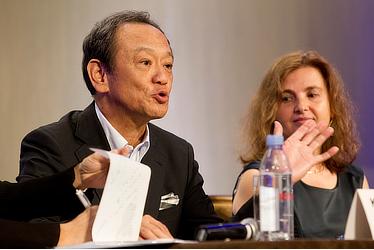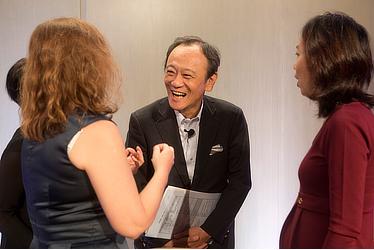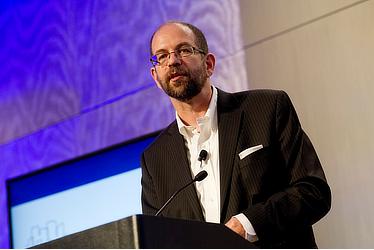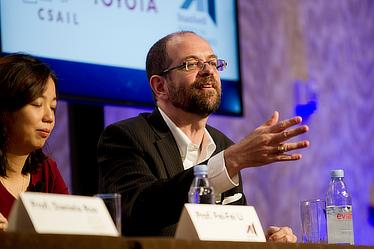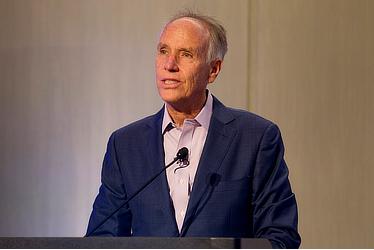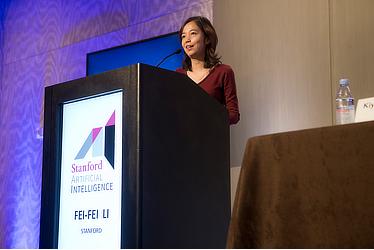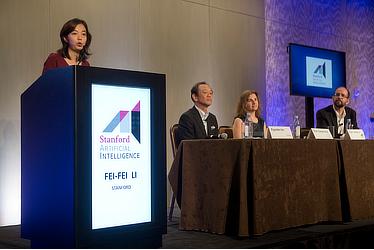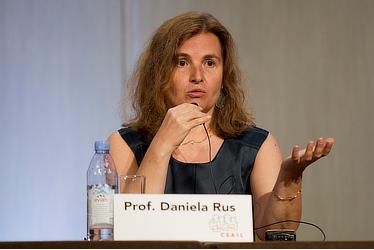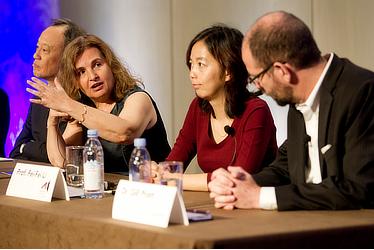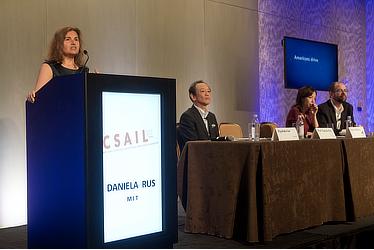Sep. 04, 2015
Toyota Establishes Collaborative Research Centers with MIT and Stanford to Accelerate Artificial Intelligence Research
- Toyota will invest $50 million to broaden its focus on computer science and human-machine interaction with an immediate goal of reducing highway injuries and fatalities
- Dr. Gill A. Pratt joins Toyota to direct overall collaborative effort at the research centers
- Professor Daniela Rus to lead joint research center at MIT
- Professor Fei-Fei Li to lead joint research center at Stanford
Palo Alto, California, U.S.A.―September 4, 2015―The research and development of intelligent vehicle and mobility technologies will get a major boost in an ambitious new collaboration between Toyota, MIT and Stanford. At a press conference today, Toyota Motor Corporation (TMC) announced that it will be investing approximately $50 million over the next 5 years to establish joint research centers at each university. Additionally Dr. Gill Pratt, former Program Manager at DARPA (the Defense Advanced Research Projects Agency) and leader of its recent Robotics Challenge, has joined Toyota to direct and accelerate these research activities and their application to intelligent vehicles and robotics.
As we age, mobility becomes more challenging; and larger segments of society are unable to drive or move freely. Also, the demands on healthcare systems and those who support the physically infirm continue to increase. Toyota believes the opportunities to improve every-day living through artificial intelligence supported technologies are boundless, with significant breakthrough potential for the development of life-saving intelligent vehicles and life-improving robots.
Kiyotaka Ise, TMC Senior Managing Officer and Chief Officer, R&D Group, said: "We're here today to mark the beginning of an unprecedented commitment. We will initially focus on the acceleration of intelligent vehicle technology, with the immediate goal of helping eliminate traffic casualties and the ultimate goal of helping improve quality of life through enhanced mobility and robotics. This partnership, directed by Dr. Pratt, is a great opportunity to work with two leading research teams from two top universities. I am very excited about what this new venture means for Toyota, and I look forward to more announcements in the future."
Dr. Gill Pratt said, "This bold collaboration will address extremely complex mobility challenges using ground breaking artificial intelligence research. I'm thrilled to be a part of the synergies and talent-sharing of Toyota, MIT, and Stanford. Key program areas will be addressed by the two university campuses and Toyota, with combined research targeted at improving the ability of intelligent vehicle technologies to recognize objects around the vehicle in diverse environments, provide elevated judgment of surrounding conditions, and safely collaborate with vehicle occupants, other vehicles, and pedestrians. The joint research will also look at applications of the same technology to human-interactive robotics and information service."
Research at MIT will be led by Professor Daniela Rus, Andrew (1956) and Erna Viterbi Professor of Electrical Engineering and Computer Science and Director of the Institute's Computer Science and Artificial Intelligence Laboratory (CSAIL). "Our team will collaborate with Stanford and Toyota to develop advanced architectures that allow cars to better perceive and navigate their surroundings in order to make safe driving decisions," said Professor Rus. "These efforts will play a major role in helping reduce traffic casualties, and potentially even helping us develop a vehicle incapable of getting into a collision."
Led by Professor Fei-Fei Li, Director of the Stanford Artificial Intelligence Laboratory (SAIL), the Stanford-based research center will collaborate with MIT and Toyota to develop advanced intelligent systems to recognize, understand and act in complex traffic environments. "Building on Stanford's expertise with computer vision, machine learning, large-scale data analysis and human-computer interaction, our team will work to help intelligent vehicles recognize objects in the road, predict behaviors of things and people, and make safe and smart driving decisions under diverse conditions," said Professor Li.
Beyond Toyota's longstanding work on autonomous vehicles and advanced driving support systems, the company has been developing robots for industrial use since the 1970s, and for Partner and Human Support Robot applications since the 2000s. This collaborative effort will open up new avenues for systems and product development across a broad range of mobility applications.
- About Dr. Gill Pratt
- http://newsroom.toyota.co.jp/en/detail/9283610/
- About Professor Daniela Rus
- https://www.csail.mit.edu/user/876
- About Professor Fei-Fei Li
- http://vision.stanford.edu/feifeili/
Remarks by TMC Senior Managing Officer Kiyotaka Ise at the Press Conference
Good morning, and thank you for coming.
Today is a very exciting day for Toyota.
First, I am happy to announce an important new research collaboration with MIT and Stanford.
Toyota will invest fifty million dollars over the next five years and establish a joint research center at each university.
Together we will conduct collaborative research into artificial intelligence and robotics technology, with key program areas divided between the two institutions.
In addition, Dr. Gill Pratt, former Program Manager at DARPA, has joined Toyota to direct these research activities.
As many of you know, Gill is a leader in this field, and we are excited to have his help in expanding our research efforts.
Today's announcement is the next step in Toyota's history with these technologies.
Our research and development into artificial intelligence and robotics technology, which can be used for autonomous systems, dates back decades.
We believe this research will transform the future of mobility, improving safety, reducing traffic congestion, and raising quality of life for everyone.
AI is a driving force behind high-tech innovation around the world.
Not only will its impact on our industry be large, it will extend well beyond cars.
We understand the importance of this technology, and we know that competition from other automakers and technology companies is increasing.
As a result, today's announcement is the beginning of an unprecedented commitment by Toyota to artificial intelligence and robotics technology research, for years to come.
With Gill's help, we plan to take on new challenges, and we will do so at a scale that matches how important we believe this work is.
Working with MIT and Stanford is an important beginning. They are not just top universities in North America. They are on the cutting edge of artificial intelligence research.
This collaboration will help Toyota to learn and to strengthen its research in computer science, and it will give us the chance to share our knowledge and push the boundaries of new technology.
When I first met Gill last April, I asked him what future mobility should look like.
Not surprisingly, we shared the same point of view. It should save lives, it should improve quality of life, and it should continue to be fun.
Of course, Gill's point of view is about two feet taller than mine, so we are pleased that he will be our beacon.
I am very excited about what this new venture means for Toyota, and I look forward to more announcements in the future.
With MIT and Stanford, and Gill's help, I am confident we will see fantastic results.





